Breathtaking Opportunities in the Content Industry Frontier
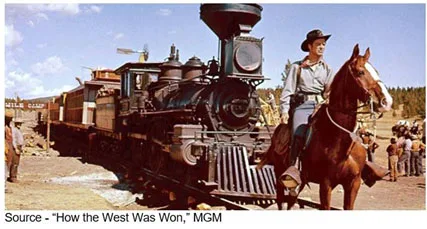
For a guy who not long ago was recommending that employees work from 9 a.m. – 9 p.m., six days a week to now advocating that we make intelligent use of AI so people will only have to have a 12-hour work week; Alibaba’s Jack Ma may have finally come up with the ultimate answer for the content development, distribution, consumption industry.
Seriously!
The content viewing landscape is getting terribly crowded and … confusing.
We have pay-TV, SVOD, AVOD, TVOD, D2C.
We have FAANG/BAT (Facebook, Amazon, Apple, Netflix, Google/Baidu, Alibaba, Tencent), AT&T TV (WarnerMedia), CBS, NBC, ABC, Hulu, HBO, Sky, BBC, Canal+, IMDb Freedive and shortly Disney+, Apple TV + and 100s of good, bad, so-so regional, national, local streaming services around the globe.
It’s getting “a little” crowded out there and consumers are saturated/confused with options!
Back before the great screen rush began, around 2009, a business friend, Jeff Hastings, took over as head of a cool company called BrightSign (a neat company that makes digital signage media players) and introduced us to the firm’s parent company’ boss, Anthony Wood.
Wood had started his sixth company, hence Roku, after leaving Netflix with a cute little gimmick that allowed us to stream content to our TV.
NBD initially, there wasn’t that much to stream; but after five generations of the product and countless me-toos like Amazon Fire and Nvidia Shield, the vMVPD (virtual multichannel video programming distributor) has become a necessity.
We like it because practically all of the stuff listed earlier is available on our Roku channel.

Our kids were especially happy a couple of years ago when Anthony rolled out the smartphone app so they didn’t have to be tied to our TV and could watch their stuff on their mobile devices when they wanted, where they wanted.
With his trademark suspenders he would never be mistaken for a content tech industry mogul like Hastings, Iger, Huang, Bezos or any of that crowd.
Instead, you’d probably think he was a smart, friendly engineer who invented the DVR (digital video recorder) and a bunch of other gadgets.
You’d be right.
What’s neat – almost indispensable in today’s expanding “channel” universe – is that these things and their apps keep you from wasting time Googling everything.
Streaming devices, sticks and apps let you flip through a warehouse full of movies, TV shows, and short videos as well as most of the new content options – ad-supported and subscription.
Sure, you sign up for the subscription stuff – Netflix, Amazon Prime, Hulu, HBO, Disney + (missed the three-year deal so we’ll go with the annual bundle) – but it saves my wife a lot of frustration looking for that show.
According to a recent Hub study, 47 percent of consumers first go to their pay-TV box; but with folks cutting the cord, that box is fading.
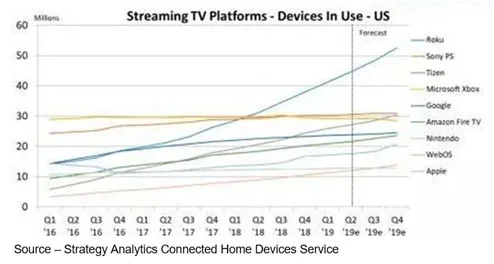
Logic says that if 45 percent of the viewers go to an online source, then streaming devices are a great way for people to check their viewing options all in one location.
Focusing on doing one thing and doing it well must work because Comscore recently found that Roku has 49 percent of the U.S. streaming box market.
Our new fave on the Roku Channel – in addition to our SVOD stuff – is the slightly irreverent Tubi streaming service.

In addition to a solid roster of ad-supported content, their marketing is just irreverent enough to appeal to our kids.
When Tubi announced they were launching in Australia, we alerted a friend down in Cairns, AU and BAM! he bought into the whole package – loved the idea of really free content viewing and telling the TV service to bugger off.
Ma advocating a 12-hour work week is a good thing because the industry is streaming more content.
It must be good because more people are watching the stuff.

Netflix, HBO, Amazon Prime have been the benchmarks for streaming services developing and releasing good, new content into the world. And doing it week in/week out, month in/month out ain’t cheap!
Netflix has been loved/despised for paying top dollar to sign up an envious string of big-name showrunners and producers.
Not one to be shy, Bezos showed he wanted some of the action (especially the shiny gold statues) by dividing his moonshot investments between Blue Origin (space venture) and what he hopes will be blue sky winning scripts, showrunners, producers and talent.
Apple’s Cook looked at his P&L statements and saw that he was making a lot more profit from content (music, books, apps) than gear, so the company put a little money on the table for Apple TV+ showrunners, producers, big names. Face it, $1B in content doesn’t go far, so we’ll see how Apple lovers respond with their titanium cards.

While everyone was running around hiring names, Iger showed the industry it’s not nice to tweak the mouse’s nose.
They have plenty of D2C streaming experience with Hulu and ESPN+; and at their D23 Expo, they unloaded their biggest barrage of content, ideas and “magic” to show they’re ready for the newest phase of individual/family entertainment:
- Titles from Pixar, Marvel, Star Wars and National Geographic as well as Fox properties including The Simpsons, Malcolm in the Middle and new original series
- All told, more than 7,500 TV episodes and 500 films will be ready when viewers are ready
- It’s probably the richest library of content for young and old
- Tic marks for just about every category a consumer would want
- All at a price of about $13 a month
- 4K Ultra HD video playback with Dolby Vision, HDR10, Dolby Atmos audio on supported devices
- Concurrent streaming on up to four registered devices
- Unlimited downloads for offline viewing of films and series on up to 10 devices
- No limit on the number of times a title can be downloaded per year
- Global availability on Android/iOS devices, Apple TV, Android TV, Roku, Xbox One and Sony’s PlayStation 4
- All backed by Disney’s hellacious marketing machine and a worldwide fanbase that is even bigger than Apple’s

If Disney signs up as many households as some analysts predict, Iger could be viewed by many as a Mr. Captain Marvel or Iron Man. If the company achieves a more modest subscription base, he could be compared to Thanos.
Either way, not bad!
Yes, content is king, but the queen for direct-to-consumer streaming services is overall user experience.
Netflix learned how to deliver that experience over the past 10+ years. Disney has sworn to deliver a flawless experience outta’ the gate.
And according to a recent PwC report, UX isn’t just important, it’s vital.
Most of the stuff that goes into delivering that experience is outside the service’s – pay-TV, SVOD, AVOD, sports/entertainment – control … the delivery infrastructure.
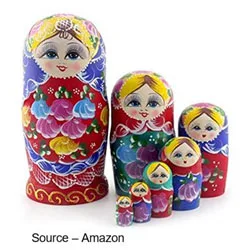
We think our family is fairly normal – at least for a Silicon Valley family.
At the end of the day, we don’t have a movie/show we’ve just gotta’ watch or life will never be the same.
Some folks say they only subscribe to the services that have new, original content; but if we’ve never seen the stuff, then it’s new, original to us.
So, when we go to our screen, we choose one of the services we have on our list – sorta’ like you know, the old cable days. Then we scroll the show/movie list, check out the titles and plot lines and after scanning a few, hit the play key. BAM! we’re on the one the wife wants to watch.
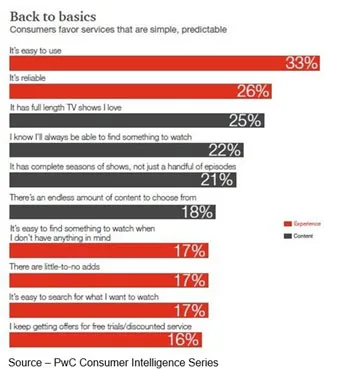
Double BAM! the entertainment begins.
If it doesn’t begin quick like a bunny, or in a very reasonable time, we are likely to choose one of our other services and their show.
If it happens a couple of times, we’ll probably cancel the subscription even if it’s an AVOD service.
Sure, people sign up for streaming services because of specific shows/movies/series.
They keep the service because they like the shows and the price is right (yes, that includes AVOD when the balance/personalization of ads, entertainment value is acceptable) and it meets their experience expectations.
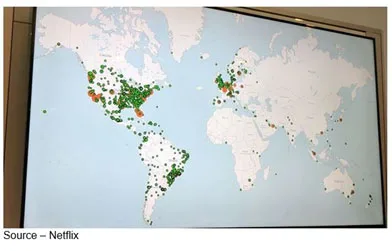
That’s the big difference between your old linear, pay-TV and streaming service.
Streaming services knew from the outset you have options.
To ensure you get the content when you want it, on the screen you want it on; Disney, HBO, Hulu, NBC, CBS, others rely on “invisible” organizations like Akamai, Microsoft, Google and other global CDN (content distribution network) services.
Netflix, Disney and other streamers intent on capturing the largest number of national and global content viewers possible, monitor the infrastructure services 24/7 to ensure content is available as close as possible to the customer to ensure the best delivery possible of the movies/shows people want.
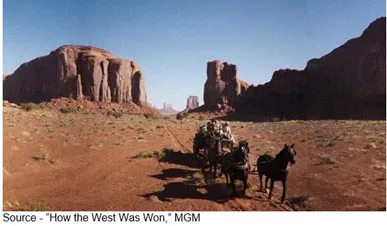 It’s a long, hard trail in the new streaming frontier and every streamer wants to be the place where folks decide to settle down and choose their service as their home for their entertainment.
It’s a long, hard trail in the new streaming frontier and every streamer wants to be the place where folks decide to settle down and choose their service as their home for their entertainment.
And with all of the services bidding for your entertainment time you just may need Ma’s 12-hour work week, so you have time to watch all the insanely great content that’s available.
That will be a problem for folks of “a certain age” who are accustomed to a five-six-day normal work week.
But for our kids, who love to binge view, they’re ready to deliver.
As Rebecca Prescott said to them, “You’ve only ate four plates, I was beginning to think you didn’t like it.”
# # #